The bird list ended at the Exhalation
of Piled-up Corpses.
... In labouring to apprehend (lit. exhaust)
patterns fully, we are not necessitated to attempt an exhaustive
and complete research into the patterns of all the myriad
phenomena in the world. Nor can we attain our aim by fully
apprehending only a single one of these patterns. It is simply
necessary to accumulate (lit. pile up and tie together, chi
lei) a large number (of phenomena). Then (the patterns) will
become visible spontaneously ...
... They dug a grave, dug it very deep, and
lined it with stones (he paenga). When that was done,
they lowered the dead into the grave. Tuu Maheke took it
upon himself to cover the area where the head lay. Tuu
Maheke said, 'Don't cover the head with coarse soil (oone
hiohio)'. They finished the burial and sat down. Night
came, midnight came, and Tuu Maheke said to his brother,
the last-born: 'You go and sleep. It is up to me to watch over
the father.' (He said) the same to the second, the third, and
the last. When all had left, when all the brothers were asleep,
Tuu Maheke came and cut off the head of Hotu A
Matua. Then he covered everything with soil. He hid (the
head), took it, and went up. When he was inland, he put (the
head) down at Te Avaava Maea. Another day dawned, and the
men saw a dense swarm of flies pour forth and spread out like a
whirlwind (ure tiatia moana) until it disappeared into
the sky ...
|
he tu-ao |
he tuvi → he tavi |
|
|
|
The dark
brown tern with a round tail is called tuao
... Ao, the world.
I was told that tavi is a small, lead-colored
bird that lives on the little islets (motu)
off the coast. He is supposed to look like the
tuvi, the grey tern, and owes his name to his
call ...
Grey tern, Tuvituvi (Procelsterna caerulea
skottsbergi) ...
Anous stolidus
unicolor
...
The calling out (ragi) of the
tuvi bird (viz. tavi) was strangely
not heard before his appearance, a sign of time
reversed. It was the same as the order between
thunder and lightning:
... It was 4 August 1968, and it
was the feast day of Saint Dominic, patron of Santo
Domingo Pueblo, southwest of Santa Fe. At one end of
the hot, dusty plaza, a Dominican priest watched
nervously as several hundred dancers arranged in two
long rows pounded the earth with their moccasined
feet as a mighty, collective prayer for rain,
accompanied by the powerful baritone singing of a
chorus and the beat of drums. As my family and I
viewed this, the largest and in some ways the most
impressive Native American public ceremony, a tiny
cloud over the Jémez Mountains to the northwest got
larger and larger, eventually filling up the sky; at
last the storm broke, and the sky was crisscrossed
by lightning and the pueblo resounded with peals of
rolling thunder ... |
|
MAY 25 (5-25) |
26 (*266) |
27 |
28 (348) |
 |
 |
 |
 |
|
Ga3-6 |
Ga3-7 |
Ga3-8 |
Ga3-9
(68) |
|
Āshleshā-9
(Embrace) /
Willow-24 (Stag)
π¹ Ursa Majoris,
δ HYDRAE (129.6),
AL MINHAR
AL SHUJĀ
= σ
Hydrae,
MUSEIDA
= π²
Ursae Majoris
(129.9)
RAS ALHAGUE (α
Ophiuchi)
|
Al Nathrah-6
(Gap)
BEEHIVE
(Exhalation of Piled-up Corpses)
= ε Cancri,
η Pyxidis (130.4),
XESTUS
= ο Velorum
(130.5), ζ Pyxidis (130.7),
ASCELLUS
BOREALIS = γ Cancri,
β Pyxidis (130.9)
*89.0 = *130.4 - *41.4 |
Extended Net-26a
(Ox) /
Arkū-sha-nangaru-sha-shūtu-12
(Southeast Star in the Crab)
η Hydrae (131.0),
ASCELLUS
AUSTRALIS = δ Cancri
(131.4),
KOO SHE
(Bow and
Arrow)
= δ Velorum
(131.6), α Pyxidis (131.8), ε Hydrae (131.9)
*90.0 = *131.4 - *41.4 |
ι Cancri (132.0), ρ Hydrae (132.4)
*91.0 = *132.4 - *41.4 |
|
... He is bound to it with
willow thongs in the 'five-fold bond' which
joins wrists, neck, and ankles together
...

... They were
Ranginui, the Sky Father, and Papatuanuku,
the Earth Mother, both sealed together in a
close embrace. Crushed
between the weight of their bodies were their many
children, whose oppression deepened. They yearned to
be free; they fought their parents and each other to
break loose. Tuumatauenga, virile god of war,
thrust and shouted; Tangaroa of the oceans
whirled and surged; Tawhirirangimaatea,
Haumiatiketike and Rongomatane, of wild
foods and cultivated crops, tried their best but
were not successful; and Ruamoko, god of
earthquakes, yet to be born, struggled in the
confinement of his mother's womb ... Of them all,
Taane Mahuta [cfr Mahute, Boussonetia
papyrifera], the god of the forests, was the
most determined; he set his sturdy feet upon his
father's chest, and braced his upper back and
shoulders against the bosom of his mother. He
pushed; and they parted. So
the world, as the Maori understand it, came into
being ...
... A man had a daughter who
possessed a wonderful bow and arrow, with
which she was able to bring down everything she
wanted. But she was lazy and was constantly
sleeping. At this her father was angry and said: 'Do
not be always sleeping, but take thy bow and shoot
at the navel of the ocean, so that we may get fire.'
The navel of the ocean was a vast whirlpool in which
sticks for making fire by friction were drifting
about. At that time men were still without fire. Now
the maiden seized her bow, shot into the navel of
the ocean, and the material for fire-rubbing sprang
ashore. Then the old man was glad. He kindled a
large fire, and as he wanted to keep it to himself,
he built a house with a door which snapped up and
down like jaws and killed everybody that wanted to
get in. But the people knew
that he was in possession of fire, and the stag
determined to steal it for them. He took
resinous wood, split it and stuck the splinters in
his hair. Then he lashed two boats together, covered
them with planks, danced and sang on them, and so he
came to the old man's house. He sang: 'O, I go and
will fetch the fire.' The old man's daughter heard
him singing, and said to her father: 'O, let the
stranger come into the house; he sings and dances so
beautifully.' The stag landed and drew near the
door, singing and dancing, and at the same time
sprang to the door and made as if he wanted to enter
the house. Then the door snapped to, without however
touching him. But while it was again opening, he
sprang quickly into the house. Here he seated
himself at the fire, as if he wanted to dry himself,
and continued singing. At the same time he let his
head bend forward over the fire, so that he became
quite sooty, and at last the splinters in his hair
took fire. Then he sprang out, ran off and brought
the fire to the people ...
 |
|
July 28 |
29 (*130) |
30 |
31 (212) |
|
°July 24 |
25 |
26 (*127) |
27 (208) |
|
'July 1 |
2 |
3
(*104) |
4 (185) |
|
"June 17 |
18 |
19 (*90) |
20 (171 = 185 -
14) |
|
... When it
grew light, Makoi arose again. He went
off to further explore the area. He went along and
came to the 'dark rat'. He looked around and said:
'Here we are at the dark rat of Hau Maka'.
He gave it the name Te Kioe Uri A Hau Maka.
He went on and came to Te Piringa Aniva. When
he arrived there, he looked around and gave the name
Te Piringa Aniva. He went on and came to
Te Pei, looked around, and said, 'Here it is!'
So he gave the name Te Pei A Hau Maka. He
went on, all alone he went on, and came to Te Pou.
When he arrived there, he looked around and again
said, 'Here it is!' and gave the name Te Pou A
Hau Maka ... [E:20]
This should have happened in "June
16, because the events in "June 15 ended as follows:
...
Makoi got up and began to familiarize himself
with the (new) land. (This took place)
on the fifteenth day of the
month of June ('Maro'). He went toward
the sheer face of the rocks (titi o te opata),
was astonished (aaa), came up to the middle
(of the outer rim of the crater), and stood at the
very edge. He looked down and saw the 'Pu
Mahore of Hau Maka' (on the coast)
and said, 'There it is, the hole of the mahore
fish of Hau Maka!' He turned his face and
looked toward the back (i.e., in the direction of
the crater). No sooner had he seen how the dark
abyss opened up (below him), when a fragrant breeze
came drifting by. Again Makoi said, 'This is
the dark abyss of Hau Maka'. He turned
around, walked on in utter amazement, and arrived at
the house. He spoke to Ira, 'Hey you, my
friends! How forgetful we (truly) are. This place is
adequate (? tau or 'beautiful'), the dark
abyss lies there peacefully!' Ira replied,
'And what should that remind us of up here?' All
arose and climbed up. They went on and arrived; they
all had a good look (at the inside of the crater).
They returned home and sat down.
Night fell, and they went to
sleep
...
[E:19]
He Tavi ("June 18)
was related to the call of
He Tuvi ("June 16).
In between it grew light (tu-ao) and here
Makoi had gone on his own to visit 4 kuhane
stations. |
|
CLOSE TO THE FULL
MOON: |
|
NOV 24 (*248) |
25 (329) |
26 |
27 |
|
ROTANEV = β Delphini,
ι Delphini (312.3), τ Capricorni (312.6), κ Delphini
(312.7),
SVALOCIN = α Delphini,
υ Capricorni, υ Pavonis (312.8) |
μ²,
μ¹
Oct. (313.2),
DENEB CYGNI (Tail of the Swan)
=
α
Cygni
(313.5),
β
Pavonis (313.6),
δ
Delphini (313.8) |
Al Sa’d al Bula'-21 (Good Fortune of the Swallower)
/
Dhanishta-24 (Most Famous) /
Girl-10 (Bat)
YUE (Battle-Axe) =
ψ
Capricorni
(314.3),
GIENAH CYGNI =
ε
Cygni,
η
Cephei (314.5),
γ
Delphini (314.6),
σ
Pavonis (314.7),
ALBALI
=
ε
Aquarii
(314.8) |
BATEN ALGIEDI (Belly of the Goat)
=
ω
Capricorni
(315.8)
BETELGEUZE (α Orionis) |
|
Jan 27 (392) |
28 |
29 (*314) |
30 |
|
°Jan 23 (388) |
24 |
25 (*310) |
26 |
|
'Jan 1 (366) |
2 |
3 |
4 (*288 = *315 - *27) |
|
"Dec 17 |
18 (*272) |
19 |
20 (354 = 395 -
41) |
The next night the Full Moon was at the Bat (the Swallower).

Right ascension day
*314 corresponded to January 29 and anciently the winter months had
only 29 nights. Then came February with the Swallow.
|
10 |
Girl |
ε Aquarii
(Albali) |
Bat |
Jan 29 (394) |
| 11 |
Emptiness |
β Aquarii
(Sadalsud) |
Rat |
Febr 9 (405) |

... In China,
with Capricornus, Pisces, and a part of Sagittarius,
it [Aquarius] constituted the early Serpent, or
Turtle, Tien Yuen; and later was known as
Hiuen Ying, the Dark Warrior and Hero, or Darkly
Flourishing One, the Hiuen Wu, or Hiuen
Heaou, of the Han dynasty, which Dupuis gave as
Hiven Mao. It was a symbol of the emperor
Tchoun Hin, in whose reign was a great deluge;
but after the Jesuits came in it became Paou Ping,
the Precious Vase. It contained three of the sieu,
and headed the list of zodiac signs as the Rat,
which in the far East was the ideograph for 'water',
and still so remains in the almanacs of Central
Asia, Cochin China, and Japan ...
 |
|
12 |
Rooftop |
α Aquarii
(Sadalmelik) |
Swallow |
Febr 18
(414) → Bharani |
|
... Now birds and fishes are born
under the sign of the Yin [Moon], but they
belong to the Yang [Sun]. This is why birds
and fishes both lay eggs. Fishes swim in the waters,
birds fly among the clouds. But in winter, the
swallows and starlings go down into the sea and
change into mussels ... |
|
13 |
House |
α Pegasi (Markab) |
Pig |
March 5 (414 + 15
= 365 + 64) |
|
March equinox |
|
14 |
Wall |
γ Pegasi
(Algenib) |
Porcupine |
March 22 = 365 +
80 + 1 |
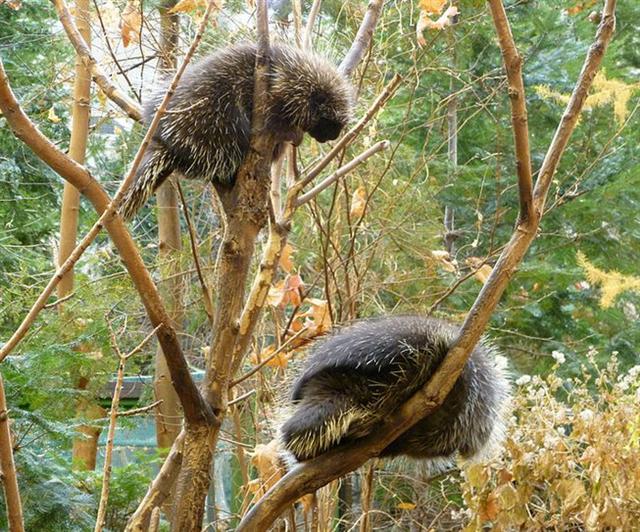 |
... In the present context 'mouth' has an
additional connotation, given that it refers in part to Heart of
Earth, the deity called 'Mundo' today. This is the great
Mesoamerican earth deity, the ultimate swallower of all living
beings, depicted in Classic Mayan art (in the Palenque relief
panels, for example) as an enormous pair of jaws upon whose lips
even the feet of great lords must rest in precarious balance,
and into whose throat even great lords must fall. Turning to the
contemporary scene, daykeepers who visit the main cave beneath
the ruins of Rotten Cane, the last Quiché capital, speak of the
danger of falling into 'the open mouth of the Mundo'
there, which is said to be more than four yards wide ...

... A
crack opened up in the ground, and
the Rat was put down into the pit, to rest there - he
hakatopa i te kioe.ki raro ki te rua.he hakarere
... [E: 4]
The ruins of
the last Quiché capital, viz.
Rotten
Cane, suggests the Rotten Melon (ε Delphini), which star
came
3 days earlier than ε Aquarii (Albali, the Swallower)
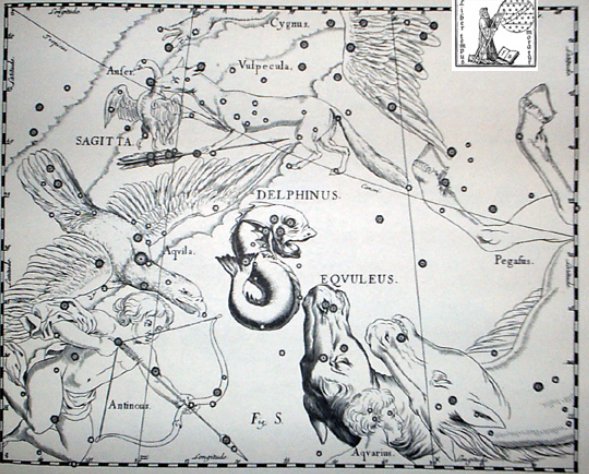

and where in Roman times
had been 'December 31. And 'more than
four yards wide' could point at day
350 + 4 = "December 20 (354 = 12 * 29½) corresponding to the
nakshatra position of MAY 28 (348 = 12 * 29 = 354 - 6) - which
in turn was a week after MAY 21:
|
Itzam-Yeh defeated |
28 May (148), 3149 BC |
|
1st 3-stone place |
21 May (141), 3114 BC |
|
Creation of our present world |
13 August (225), 3114 BC |
|
Och ta chan (Hun-Nal-Ye 'entered or became the sky') |
5 February (36), 3112 BC |
|
21 May, 3114 BC - 5 February, 3112 BC =
542 |
|
542 'happens to be' the sum of 365 days
and 6 * 29½ nights. |
The calendar structure might have stood intact in spite of the
fact that the
precession pushed the Sun earlier and earlier.
|
he ruru he taiko |
he kumara he kiakia |
he tuvi |
|
Sula cyanops
... It should be pointed out that
the combined name ruru-taiko refers in
MAO. to a black petrel (Procellaria
parkinsoni). There are no cultural data
available for ruru, which seems to be derived
from PPN. *lulu 'owl'...
There are no cultural data available for ...
taiko (compare RAR. taiko 'black petrel',
MGV. tiaku 'petrel?, omen of death', but the
textual association of taiko and spirits
should be dept in mind ...

...
The transference of the name for
sweet potatoes, kumara, to a sea bird (Oestrelata
incerta or Oestrelata leucoptera)
presents a problem in taxonomy. In a short
recitation that accompanies the string game, the
next bird on the list, kiakia, the white
tern, is associated with the leaves of the sweet
potato ...
White tern. Leucanus albus royanus
...
... Grey tern, Tuvituvi (Procelsterna
caerulea skottsbergi)
...
Anous stolidus
unicolor
... The dark
brown tern with a round tail is called tuao
... I was told that tavi is a small,
lead-colored bird that lives on the little islets (motu)
off the coast. He is supposed to look like the
tuvi, the grey tern, and owes his name to his
call ... |
|
MAY 20 (140) |
21 (*61) |
22 |
23 |
24 (144 = 12 *
12) |
 |
 |
 |
 |
 |
|
Ga3-1 |
Ga3-2 |
Ga3-3 |
Ga3-4 |
Ga3-5
(64) |
|
AL TARF (The End)
= β Cancri
(124.3)
RAS ALGETHI (α
Herculis)
|
χ Cancri (125.2),
BRIGHT FIRE
= λ Cancri
(125.4)
*84.0 = *125.4 - *41.4 |
AVIOR
= ε Carinae
(126.4), φ Cancri (126.8)
*85.0 = *126.4 - *41.4 |
ο Ursae Majoris
(127.4)
*86.0 = *127.4 - *41.4 |
Pushya-8
(Nourisher)
υ Cancri (128.1),
θ CANCRI
(128.2) |
|
July 23 (204) |
24 (*125) |
25 |
26 (187 + 20) |
27 (208) |
|
°July 19 (200) |
20 (*121) |
21 |
22 / 7 |
23 (204) |
|
26 (177 = 6 * 29½) |
'June 27 |
28 |
29 (*100) |
SIRIUS |
|
"June 12 |
13 (*84) |
14 (165 + 365) |
Te Maro 15 |
16 |
|
Day 365 + 166 = 531 = 18 * 29½ (Te
Maro 15).


 |
|
... Makoi got up and began
to familiarize himself with the (new) land. (This
took place) on the fifteenth
day of the month of June ('Maro'). He
went toward the sheer face of the rocks (titi o
te opata), was astonished (aaa), came up
to the middle (of the outer rim of the crater), and
stood at the very edge. He looked down and saw the 'Pu
Mahore of Hau Maka' (on the
coast) and said, 'There it is, the hole of the
mahore fish of Hau Maka!' He turned his
face and looked toward the back (i.e., in the
direction of the crater). No sooner had he seen how
the dark abyss opened up (below him), when a
fragrant breeze came drifting by. Again Makoi
said, 'This is the dark abyss of Hau Maka'.
He turned around, walked on in utter amazement, and
arrived at the house. He spoke to Ira, 'Hey
you, my friends! How forgetful we (truly) are. This
place is adequate (? tau or 'beautiful'), the
dark abyss lies there peacefully!' Ira
replied, 'And what should that remind us of up
here?' All arose and climbed up. They went on and
arrived; they all had a good look (at the inside of
the crater). They returned home and sat down. Night
fell, and they went to sleep
... [E:19]
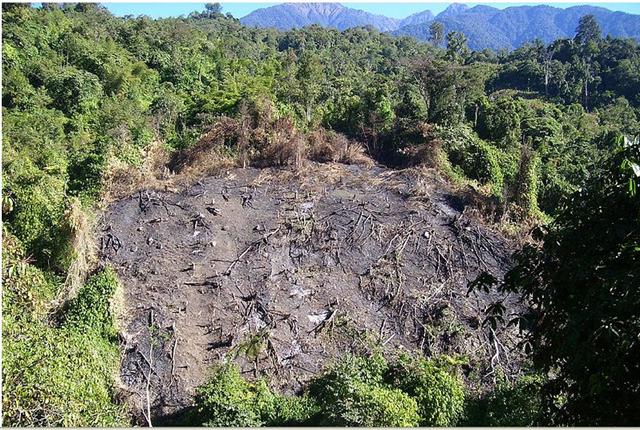 |
|
CLOSE TO THE FULL
MOON: |
|
NOV 19 (*243) |
20 (324) |
21 |
22 |
23 |
|
GREDI (Goat)
=
α
Capricorni
(307.2),
σ
Capricorni (307.5),
ALSHAT (The Sheep)
=
ν
Capricorni
(307.9) |
Al Sa’d al Dhabih-20 (Lucky One of the Slaughterers)
/
Ox / Herd Boy-9
(Buffalo)
DABIH
=
β
Capricorni
(308.0),
κ
Sagittarii (308.1),
SADIR (Hen's Breast)
=
γ
Cygni
(308.4),
PEACOCK
=
α
Pavonis
(308.7)
*267.0 = *308.4 - *41.4 |
OKUL = π Capricorni
(309.6),
BOS = ρ Capricorni
(309.9)
ARNEB (α Leporis)
MINTAKA (δ Orionis)
|
ο
Capricorni (310.2),
θ
Cephei (310.5)
HEKA (λ Orionis)
ALNILAM (ε Orionis)
|
ROTTEN
MELON
= ε Delphini,
φ Pavonis (311.2), η Delphini (311.4), ζ Delphini, ρ
Pavonis (311.7)
PHAKT (α Columbae)
ALNILAK (ζ Orionis)
|
 |
|
Jan 22 |
23 (388) |
24 |
25 (*310) |
26 |
|
°Jan 18 (383) |
19 |
20 |
21 (*306) |
22 |
|
'Dec 27 (360) |
28 |
29 |
30 |
31 (*284) |
|
"Dec 12 (*266) |
13 |
14 (348) |
14 |
16 |
Evidence is piling up
for us and the result is a kind of perspective.
... Another iconographic phenomenon, which we can learn from
Wilkinson, is the perspective relating water to the horizon:

The horizon, where the sea and the sky were
joined close together, was far away and for the eye it appeared to be
higher up than where the observer was standing. This idea we can
find also in the vocabulary of the Polynesians:
Eke. To
climb, to mount, to mount (a female for copulating), to surface
(of fish), and by extension, to bite; he eke te kahi the
tuna bites. Vanaga. Trestle, stilt; to mount a horse, to go
aboard. Hakaeke, to cause to mount, to carry on a boat. P
Pau.: fakaeke, to transport, to carry, to hang up. Mgv.:
eke, to embark, to mount upon an elevation. Mq.: eke,
to rise, to go aboard; hakaeke, to heap up, to put upon,
to raise. Ta.: ee, to mount, to go aboard; faaee,
to hang up, to transport by water. Churchill.
Iri. 1. To
go up; to go in a boat on the sea (the surface of which gives
the impression of going up from the coast): he-eke te tagata
ki ruga ki te vaka, he-iri ki te Hakakaiga, the men boarded
the boat and went up to Hakakainga. 2. Ka-iri ki puku
toiri ka toiri. Obscure expression of an ancient curse.
Vanaga. Iri-are, a seaweed. Vanaga.
Moreover, in Egyptian art a distance far away
was not depicted, Wilkinson says, by decreasingly small figures
but by 'heaping up' horizontal elements. This concept was
evidently used when building pyramids (heaps of stones):
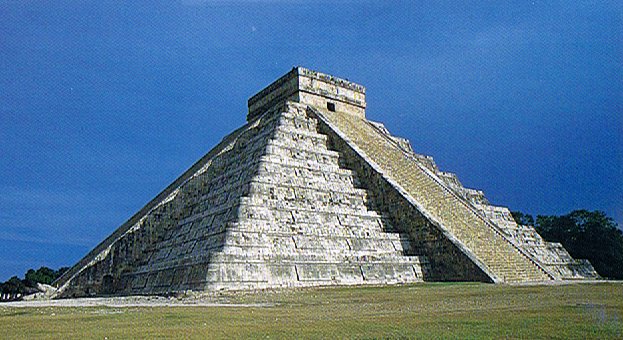
... I walked towards it now, and spent some
time strolling around it and clambering over it. Originally it
had been a clean-sided step-pyramid of earth faced with large
andesite blocks. In the centuries since the conquest, however,
it had been used as a quarry by builders from as far away as La
Paz, with the result that only about ten per cent of its superb
facing blocks now remained. What
clues, what evidence, had those nameless thieves carried off
with them?
As I climbed up the broken sides and around
the deep grassy troughs in the top of the Akapana, I
realized that the true function of the pyramid was probably
never going to be understood. All that was certain was that it
had not been merely decorative or ceremonial. On the contrary,
it seemed almost as though it might have functioned as some kind
of arcane 'device' or machine. Deep within its bowels,
archaeologists had discovered a complex network of zigzagging
stone channels, lined with fine ashlars. These had been
meticulously angled and jointed (to a tolerance of one-fiftieth
of an inch), and had served to sluice water down from a large
reservoir at the top of the structure, through a series of
descending levels, to a moat that encircled the entire site,
washing against the pyramid's base on its southern side
...
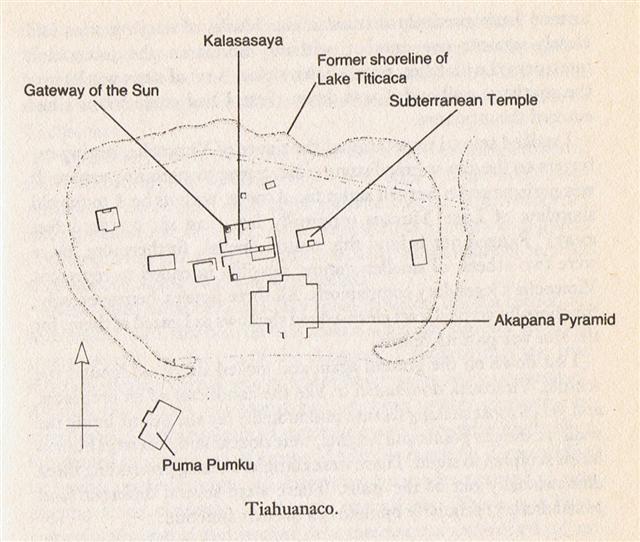
What came after the Gap (the Crack, Te Rua) - i.e. Al
Nathrah (Beehive, Exhalation of Piled-up Corpses)?
Rua. 1. Two; second;
other (precedes the noun); te rua paiga, the other side.
2. Hole, grave; holes in the rocks or between the rocks of the
coastal lagoons; he keri i te rua, to dig a hole. 3. To
vomit. Vanaga. 1. Two. P Mgv., Ta.: rua, id. Mq.: úa.
2. Nausea, seasickness, to vomit, disgust; hakarua, to
vomit, to spew. PS Mgv.: aruai, ruai, to vomit.
Mq.: úa, id. Ta.: ruai, id. Pau.: ruaki,
id. Sa.: lua'i, to spit out of the mouth; lulua,
to vomit. To.: lua to vomit. Fu.: lulua, luaki,
id. Niuē: lua,
id. Viti: lua, id.;
loloa, seasick. 3.
Cave, hollow, ditch, pit, hole, beaten path, grave;
rua papaka, a ditch. P Pau.:
rua, a hole. Mgv.:
rua, a hole in the
ground, ditch, trench. Mq.: úa,
dish, hole, cavern. Ta.: rua,
hole, opening, ditch. Churchill.
Ta.: ruahine,
an old woman. Ma.: ruahine,
id. Ta.: ruaroa,
tropic of Capricorn. Mq.: uaoa,
a constellation, the eleventh month. The sense in Tahiti is
probably that of some constellation which may be used to
determine the position. Ta.: ruau,
an old man, an old woman. Ha.: luau,
a parent. Churchill.
LUA, s. Haw., a pit, hole, cave; v. to dig
a hole; also in ancient times a process of killing a man by
breaking his back or bones; lua-lua, be flexible, pliant,
soft, old garments, a road with many small ravines crossing it;
lua-u and lua-ni, a parent; lua-hine, an
old woman. Mang., rue-ine, id. Sam., lua, hole,
pit; lua-o, an abyss. Tah., rua, hole, pit;
rua-rua, to slander, to backbite; rufa, worn out, as
garments; rua-u, old, stricken in years; s. old
man or woman. Tong., luo, hole. N. Zeal., rua, id.
Fiji., rusa, decayed perished. Malg., loakh,
luaka, hole, cave, pierced. Greek, τρυω, τρυχω,
to rub down, wear out, waste; τρυςω, toil, labour;
τρυπα, τρυμη, a hole; τρυπανον, a borer,
auger; τρυχος, a tattered garment, rags; τρυφη,
softness, delicacy; θρυπτω,
break in pieces. Liddell and Scott refer these words to
τειρω, to rub, rub away, as
derivatives of it, wear out, and τειρω, to the
Sanskrit tŗi, to pass over,
hasten, fulfil, &c. Benfey also concurs in that derivation when
he refers τρυμα, a hole, and τρυτανη, the tongue
of a balance, to the same tŗi. With due deference to so
great authorities, I would suggest that the above group of Greek
words be referred to the Sanskrit ru, lu, lædere,
secare, with the prefix t; and they would thus at once
fall into line with their Polynesian relatives, whose
development of sense is perfectly analogous to the Greek group,
though their development of form has been arrested. It may be
noted, moreover, as distinctive of the two roots, tŗi and
ru, that while from the former - to pass over frequently,
to rub, to smootheen - the idea of 'young, fresh, a youth' (taruna),
'soft, delicate' (τερην), 'tender, soft, and childhood' (tener),
were developed, the root ru, lu, gave birth to the
idea of 'old age, weakness, crumpled, flexible, as an old
garment'; lua, lua-u, τρυχος. Lat., trua,
trulla, a tray, ladle, basin; ruo , to tumble
down, but whose primary sense must have been 'to dig', as
evidenced in the phrase 'ruta et cæsa', and in rutrum,
a spade, mattock. Quære, rus, country, from ruo,
to dig, cultivate? Goth., riurs, mortal, corruptible.
Scand., rye; Swed., rycka, pull up, pluck out.
Anc. Slav., ryti, to dig; ruvati, to tear away.
Irish, ruam, a spade; rumhar, a mine; rumahar,
labour. Fornander.
According to Manuscript E
a Crack
opened up in the ground, and
the Rat was put down into this pit, to rest there. He was
nourished by sweet potatoes:
... he hakatopa i te kioe.ki raro
ki te rua.he hangai.hai
kumara.ai ka hoa no.i te kumara.te raa te raa.
he tuu ki te tahi marama he ui.a Oti.ku piere.ana.te kioe.
Piere. Thousand;
ka-piere, ka-piere, thousands and thousands (meaning: many,
lots and lots). Vanaga. 1. A thousand, a great number. 2. Resin
(? Fr.: brai); piere hiva, tar, pitch; akui ei
piere hiva, to tar. Hakapierehiva, to tar. Churchill.
Five lines of Easter Island script (of unknown origin) plus the
name Vaka.a Teatea. (The Eighth Land, p. 290.)
he haka.hetu. a Oti.i
taana.kiōe.
[E: 4]
Hetu 1. To (make) sound; figuratively:
famous,
renowned. 2. To crumble into embers (of a bonfire).
Hetu'u. Star, planet; hetu'u popohaga
morning star; hetu'u ahiahi evening star;
hetu'u viri meteorite. Vanaga. Hetu 1. Star (heetuu);
hetu rere, meteor; hetu pupura, planet. P Pau.:
hetu, star. Mgv.: etu, id. Mq.: fetu, hetu,
id. Ta.: fetu, fetia, id. The alternative form
fetia in Tahiti, now the only one in common use, need not be
regarded as an anomaly in mutation. It seems to derive from
Paumotu fetika, a planet. Its introduction into Tahiti is
due to the fashion of accepting Paumotu vocables which arose
when the house of Pomare came into power. 2. Capital
letter (? he tu). 3. To amuse. 4. To stamp the feet.
Hetuhetu, to calk, to strike the water. Hetuke, sea
urchin. Churchill.
He (the Rat) seems to
have become a
Star (hetu) when he was finished (Oti) - his spirit went
up into the sky.
Oti. To come to an
end; to suffice, to be enough: ku-oti-á, it is finished;
ina kai oti mo kai, there is not enough to eat; he-oti
á, there isn't anymore left, it's the last one; it's enough
with that. Vanaga. Ta.: 1. Oti, presage of death. Sa.:
oti, to die. 2. To cut. Mq.: koti, oti, id.
Sa.: 'oti, id. Ma.: koti, id. Churchill.

|























